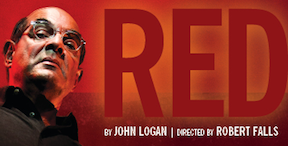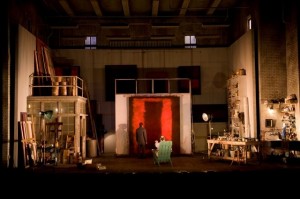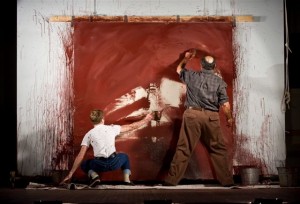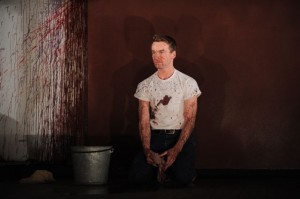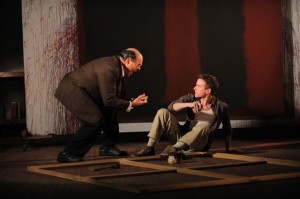A PALE SHADE OF RED
The closing stage picture in John Logan’s 2010 Tony-winning Red at the Goodman is about as thrilling and breathtaking as theater gets: as Abstract Expressionist painter Mark Rothko (Edward Gero) examines one of his paintings commissioned by an upscale restaurant in New York, the spectacular lighting (Keith Parham) and set design (Todd Rosenthal) has the painting come alive with a glowing ferocity. Certainly, one can experience emotions gazing at a painting, but this moment elucidates how theater can heighten that experience. Sadly, director Robert Falls and his cast of two were not able to apply the brushstrokes necessary to make an extraordinarily brilliant script come to life with the same power as that final image.
Unlike the movie Pollack, which detracted from what made Pollack such a fascinating artist by interminably concentrating on the artist’s drinking and constant romantic bickering, Red is intriguing because it gives us an artist – the true-life painter Rothko – who lets us know very little about his messy personal life, but instead comments passionately about what drives an artist and the business of making art.
John Logan wisely creates the character of Ken (Patrick Andrews), an assistant who works with Rothko for two years in the artist’s studio; Ken is the Warhol-worshipper who wants to be a great painter himself. This gives Rothko the opportunity to forcefully impart his views on what makes an artist great. For example, he notes that you can’t discuss art without having read Nietzsche or Hamlet: “You can not be an artist unless you are civilized. You can not be civilized until you learn. To be civilized is to know where you belong in the continuum of your art and your world. To surmount the past, you must know the past.”
Indeed, it is Ken’s past – one that involves his dead parents – that becomes the conflict; this gives us insight into how Rothko himself deals with unpleasant memories: Rothko is almost dismissive towards Ken’s familial revelations; he is far more concerned with how those memories feed one’s art than in the memories themselves.
Since the play is rife with pontifications and cerebral language, the actors must be flagrantly passionate. While the script itself remains fascinating, engaging, and thought-provoking, the Goodman production lacks a fiery internal life, largely due to Gero’s interpretation. While maintaining an uncanny resemblance, Gero softened his approach to Rothko, creating a vulnerable, placid, subtly intense artist that only hinted at the painter’s infamous petulance, fiery temper and volatilility. Thus, Andrews is left to appear threatened by someone who is not very threatening. As a result, there were moments that were so lulling that it took a personal force to keep my mind from wandering; then my attention was snapped into being by a breakthrough in character or delicious dialogue that crackled and sputtered.
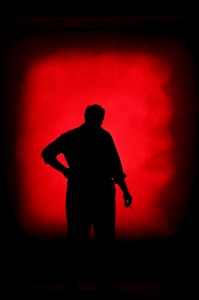 Every internal conflict in Rothko – art versus commerce, old guard versus new, talent versus skills – comes to a head in one line as he gives the reason for dismissing his young assistant: “Because your life is out there!” The playwright even saw fit to italicize the line in the script, adding an exclamation point. Yet Mr. Gero’s interpretation of a kinder, gentler Rothko had the line fall as flat as the muslin stretched along a wooden frame. Therefore, the play’s examination of the intellectualism, psychology, and struggle behind art lacked intensity and emotion, creating an evening that leaned more towards didacticism than inspiration.
Every internal conflict in Rothko – art versus commerce, old guard versus new, talent versus skills – comes to a head in one line as he gives the reason for dismissing his young assistant: “Because your life is out there!” The playwright even saw fit to italicize the line in the script, adding an exclamation point. Yet Mr. Gero’s interpretation of a kinder, gentler Rothko had the line fall as flat as the muslin stretched along a wooden frame. Therefore, the play’s examination of the intellectualism, psychology, and struggle behind art lacked intensity and emotion, creating an evening that leaned more towards didacticism than inspiration.
When Stage and Cinema writer Sarah Taylor Ellis reviewed the original Broadway production, she presciently noted that while Logan’s play is beautifully poetic in its own right, Red could not exist without the dynamic performances of Alfred Molina and Tony-winner Eddie Redmayne, both from the original production at the Donmar Warehouse in London.
In order for Red to soar, the audience must be active participants and collaborators in Rothko’s studio, which we are invited to do at the onset when Rothko speaks his first line to his eager assistant: “What do you see?” There was little magic in the Goodman production because we “see” the script, but we do not feel it. We need a director as curator and actors as docents to bring this art – the script – to vivid life. Without them, we are left to appreciate the beauty of a spectacular piece of art – a stunning technical achievement of set and lights – as if it were hanging on a wall in a museum.
photos by Liz Lauren
Red
Goodman Theatre, 170 North Dearborn
ends on October 30, 2011
for tickets, call 312.443.3800 or visit Goodman Theatre
for more shows, visit Theatre in Chicago
